Witness the intricate dance between bees and coneflowers, revealing the complexities of nature's pollination process.
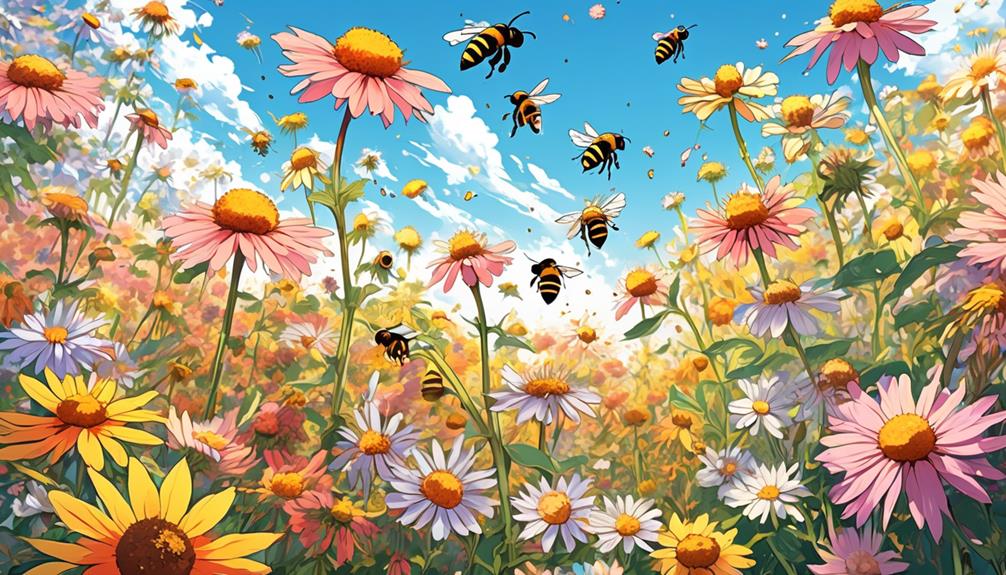
Do Bees Like Coneflowers?
Imagine you're strolling through a lush garden on a sunny afternoon, and you spot a swarm of bees buzzing around a cluster of vibrant coneflowers. You can't help but wonder: Do bees have a particular affinity for these flowers?
While it's clear that bees are critical for pollination, the specifics of their flower preferences might not be as straightforward. As it turns out, the relationship between bees and coneflowers is more complex than you might think, and exploring it could provide intriguing insights into the natural world.
Key Takeaways
- Coneflowers rely heavily on bees for pollination and reproduction.
- Bees are attracted to coneflowers due to their unique design and the guidance provided by the petals.
- Bees play a vital role in the survival of coneflowers and other wildlife species by transferring pollen.
- Bee preferences for certain flowers are influenced by characteristics such as bright colors, ample nectar and pollen, easy accessibility, and sweet scents.
Understanding the Coneflower
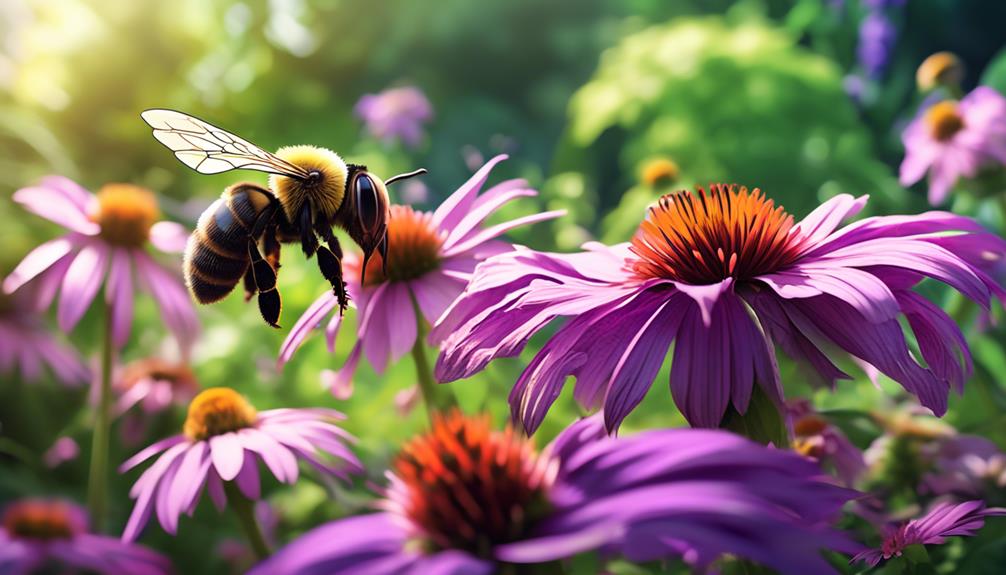
To truly comprehend the interaction between bees and coneflowers, you need to first understand the essential characteristics and lifecycle of the Coneflower, a perennial plant renowned for its vibrant colors and hardy nature.
Coneflowers, scientifically known as Echinacea, are native to North America and belong to the Asteraceae family. They're recognized for their prominent cone-shaped centers, surrounded by colorful petals that typically range from purple to pink.
Coneflowers are hardy, drought-resistant, and thrive in full sun to light shade. They can easily adapt to various soil conditions, but they prefer well-drained soil. Their blooming period is quite extensive, typically starting in early summer and continuing till late autumn. This long blooming period is a major factor that attracts bees, as it provides a consistent source of nectar.
Understanding the lifecycle of coneflowers is also crucial. They start as seeds, germinate in spring, bloom in summer, and finally die back in winter, only to return the next spring. This lifecycle offers bees regular access to coneflowers, thus creating a symbiotic relationship.
It's this unique combination of characteristics that makes the coneflower an essential part of the ecosystem, and a favorite among bees.
The Importance of Bees
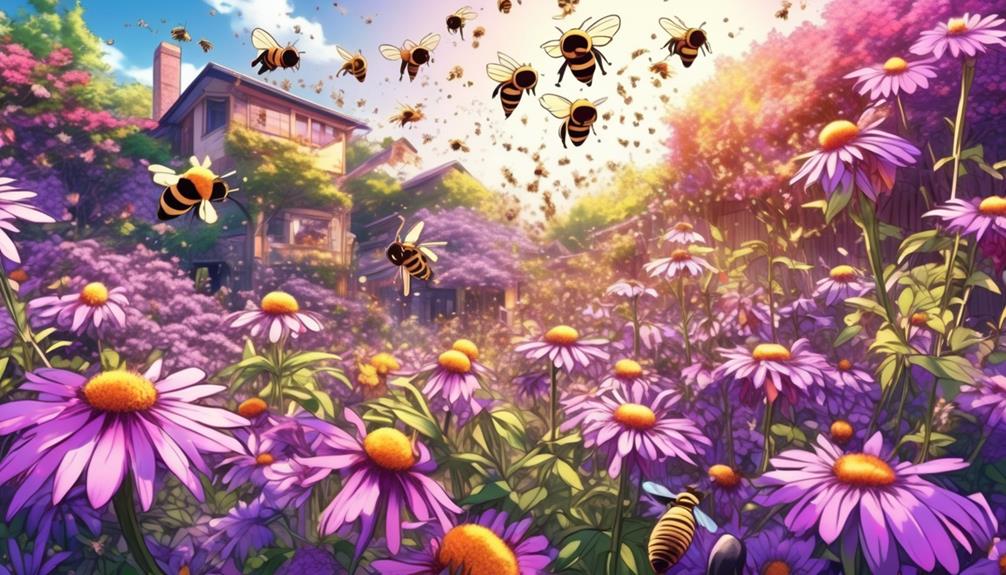
Understanding the crucial role bees play in pollination, especially for plants like coneflowers, is paramount for appreciating their significance in our ecosystem. You mightn't know this, but bees are widely recognized as the world's most important pollinator of food crops. Without their hard work, about a third of the food we eat would suffer.
Focusing on coneflowers, bees play an essential role. These blossoms have a unique shape that's just right for bees. Their large, flat landing pad is perfect for bees to land on and collect or deposit pollen. When bees visit coneflowers, they're not just gorging on nectar; they're aiding in the plant's reproduction by transferring pollen.
But let's widen the lens a bit. Bees' influence isn't restricted to our gardens or farms. They're critical for the survival of various wildlife species too. Plants pollinated by bees provide habitat, food, and resources for a vast array of creatures.
Coneflowers and Their Pollinators
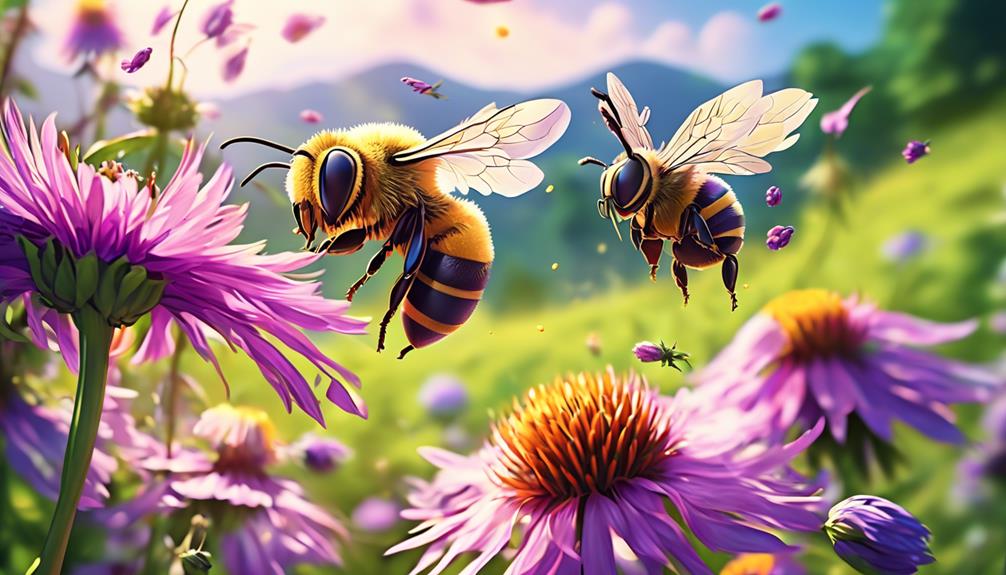
Now, let's shift our attention from the role of bees in general to specifically how coneflowers interact with their pollinators. Coneflowers, scientifically known as Echinacea, rely heavily on pollinators for reproduction. They're a prime example of mutualistic symbiosis, where both organisms benefit. In this case, bees get the nectar they need, and in return, they help the coneflowers reproduce by transferring pollen.
You'll notice that coneflowers have a unique design that's incredibly efficient for pollination. They've got a prominent, cone-shaped center filled with tiny tubular flowers, which are rich in nectar. This cone acts like a beacon, attracting bees and other pollinators. Once the bees land, they inadvertently brush against the pollen-laden anthers of the tubular flowers while drinking nectar.
But what's fascinating is that the coneflowers' petals aren't just for show. They're actually designed to guide bees towards the nectar, acting like landing strips. This ensures that the bees don't miss the pollen-rich center.
In this intricate dance of nature, it's clear that coneflowers and their pollinators share a symbiotic relationship that benefits both parties and contributes to the biodiversity of our ecosystems.
Why Bees Prefer Certain Flowers
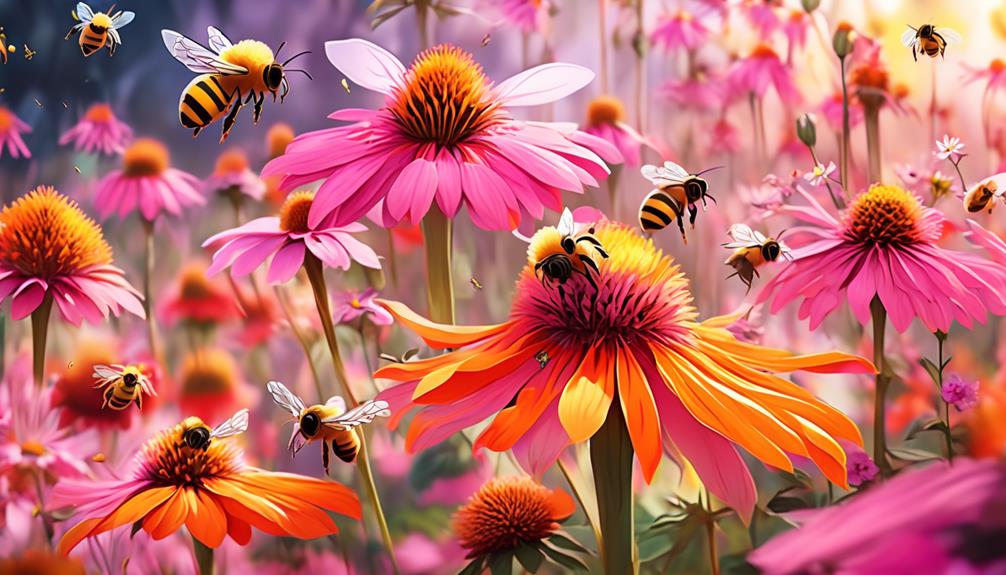
You might wonder why bees seem to prefer certain flowers, such as coneflowers, over others. The answer lies in their fundamental biology and ecology. Bees have evolved to seek out specific characteristics in flowers that maximize their energy intake and pollen gathering.
| Flower Characteristic | Bee Preference | Explanation |
|---|---|---|
| Plant | Benefit for Bees | |
| Lavender | Rich in nectar, attracts a variety of bees | |
| Sunflowers | Provides both nectar and pollen | |
| Rosemary | Blooms for a long period, providing consistent food source |
In addition to plant selection, you'll want to ensure your garden offers a safe haven for bees. Avoid using pesticides which can harm them. Instead, opt for organic gardening methods. Providing a source of shallow water will also encourage bees to frequent your garden.
Remember that bees are attracted to gardens that offer a diverse range of flowering plants. The more variety you have in your garden, the more likely you are to attract a broad spectrum of bee species. With careful planning and selection, your garden can serve as a buzzing haven for these vital pollinators.
Frequently Asked Questions
What Other Insects Are Attracted to Coneflowers?
Apart from bees, you'll find that a variety of insects are attracted to coneflowers. Butterflies, like the Monarch or Swallowtail, often hover around these flowers. You'll also notice ladybugs and other beetles. Even hummingbirds, though not insects, are drawn to coneflowers.
However, it's not just about the nectar. Coneflowers' large, flat heads make an ideal landing space for many insects, providing a beneficial relationship between the plant and the insect.
Are There Any Potential Risks to Bees When They Pollinate Coneflowers?
You're wondering about potential risks to bees when they pollinate coneflowers. There's no known harm to bees from coneflowers. In fact, coneflowers are beneficial, providing nectar and pollen.
However, if pesticides have been used on the plants, they could harm the bees. It's critical to avoid using harmful chemicals in gardens where bees are active. So, while coneflowers themselves aren't risky, human intervention can introduce hazards.
How Does the Climate or Season Affect the Relationship Between Bees and Coneflowers?
The climate or season can significantly impact the relationship between bees and coneflowers. In warmer seasons, you'll notice more bees around coneflowers as they're in full bloom.
However, during colder months, bees aren't as active and coneflowers aren't in bloom. Therefore, the interaction decreases.
Severe weather conditions, like droughts or heavy rains, can also affect coneflowers' growth, indirectly affecting their relationship with bees.
It's a delicate balance, heavily dependent on environmental factors.
Can Bees Transfer Pollen From Coneflowers to Other Plant Species?
Yes, bees can transfer pollen from coneflowers to other plant species. As they move from flower to flower, they inadvertently carry pollen on their bodies. This process, called cross-pollination, is crucial for biodiversity.
It helps plants produce offspring with a mix of genetic traits. So, when a bee visits a coneflower and then another plant, it's likely transferring pollen and contributing to the genetic diversity of the plant population.
What Other Types of Flowers Do Bees Prefer in Addition to Coneflowers?
You're curious about what other flowers bees favor, aren't you?
Besides coneflowers, bees are quite partial to many plants. They love sunflowers, lavender, and poppies, to name a few. You'll often find them buzzing around sage, thyme, and borage as well.
Bees are attracted to these plants due to their abundant pollen and nectar supply. So, if you're planning a bee-friendly garden, these flowers would be excellent choices.
Conclusion
In summary, bees sure do love coneflowers. Their bright, enticing colors and bountiful nectar nourish these diligent pollinators.
Science confirms this bee-coneflower connection, enhancing our understanding of nature's complex relationships.
You can support these industrious insects by planting more coneflowers in your garden. Remember, it's not just about beautifying your green space, it's about contributing to a thriving ecosystem.



